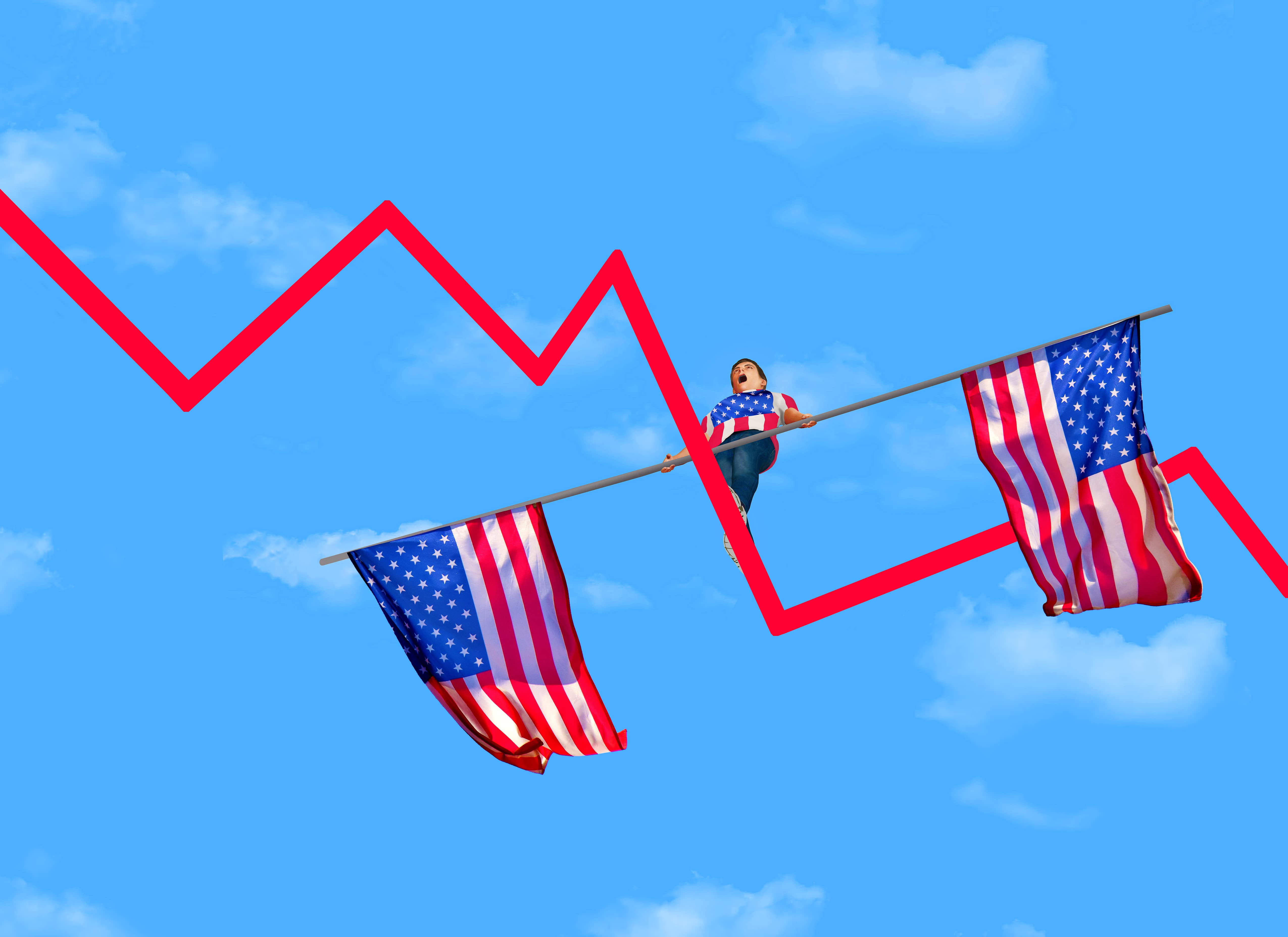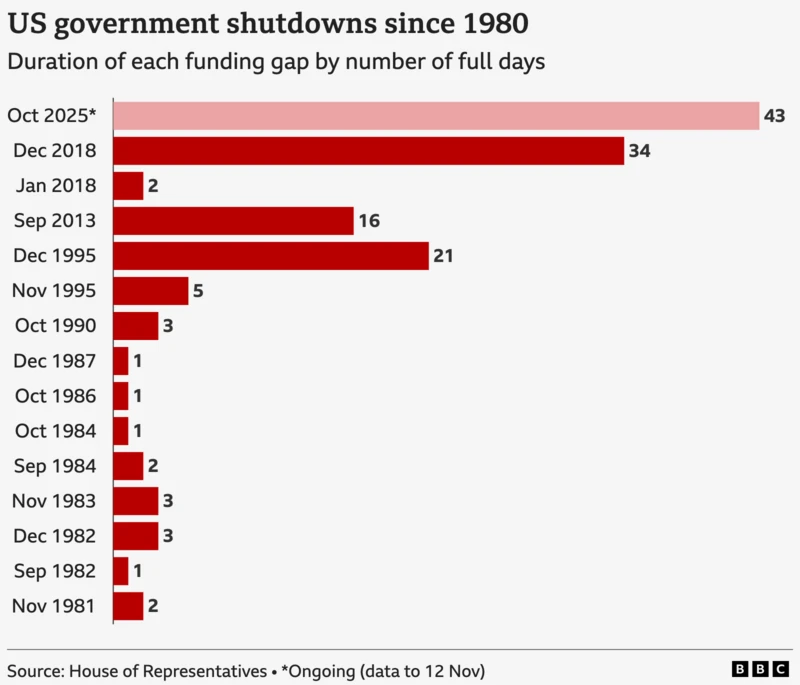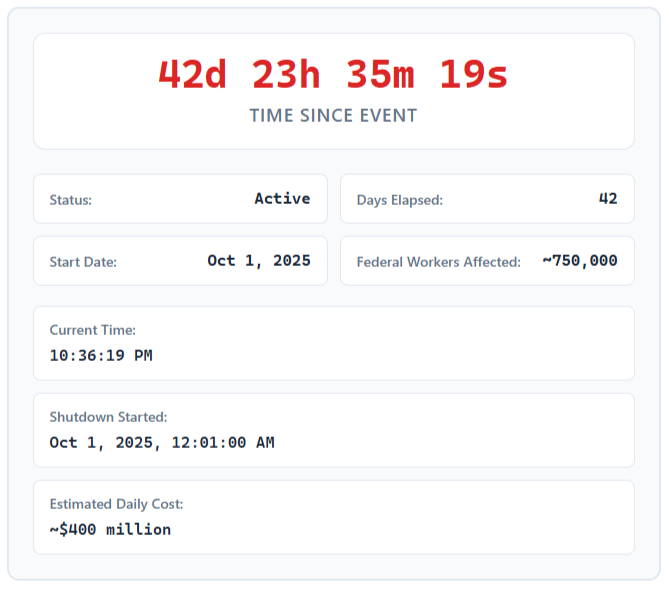市场资讯及洞察

The longest government shutdown in US history has finally ended after 42 long days.
After a month and a half of political theatre, seven Democrats and one independent broke ranks and voted with Republicans to pass a stopgap measure. The Senate went 60-40, the House followed 222-209, and Trump signed it hours later.
The legislation includes three-year appropriations for the Agriculture Department, FDA, military construction, veterans affairs, and congressional operations, along with restoration of pay for federal workers and reversal of Trump administration layoffs through January.
However, the most contentious issue, healthcare subsidies, has been kicked down the road to a December Senate vote.

COVID-era ACA subsidies expire at year-end. When they do, premiums for the average subsidised household will more than double from $888 to $1,904 per year, with an estimated 3.8 million people losing coverage entirely.
If the December vote fails, which is likely considering how far apart the two parties are on the topic, we could see a new shutdown begin in January.

What Happens Next?
This Week:
- Federal employees return to work.
- Paychecks start flowing again.
- SNAP benefits get restored for 42 million people, though heating assistance won't come back for weeks.
- National parks reopen.
- Airports start to go back to normal.
December:
- Senate votes on healthcare subsidies. It will probably fail.
- Premium notices continue to be sent showing 2026 costs doubling.
January 30:
- Government funding expires.
- We do this whole thing over, except now the healthcare subsidies have already expired.
- If Republicans and Democrats remain divided on budget priorities, another shutdown will likely begin.
By the Numbers:
Over the past 42 days, approximately 750,000 federal workers have been furloughed. Another two million worked without pay. Over 42 million had their food assistance delayed. And the FAA cut flights by 10% because air traffic controllers stopped showing up to work.

Further concern is the "data blackout" that has hampered Federal Reserve decision-making. Key economic indicators, including jobs reports, were suspended, leaving the Fed blind during an active rate-cutting cycle.
Meanwhile, separate analyses from Challenger, Gray & Christmas showed layoffs surged 183% in October, which would make it the worst October for jobs since 2003.
The Bottom Line
Today’s deal ended the shutdown, but it didn’t actually solve anything. The deal essentially kicks the can down the road to January while leaving the healthcare crisis unresolved.
With both parties divided on healthcare and spending priorities, and Trump lacking a comprehensive plan to address rising premiums and high deductibles, a resolution in the December vote seems unlikely.
If no compromise is accepted by the time Government funding expires on January 30, another shutdown is almost inevitable.
Impact of Australian Jobs Reports and U.S. Shutdown End on the Aussie


In the Australian share market, the focus remains on the earnings report. Most sectors were trading in negative territory with significant losses in the energy and information technology sectors. The technology sector was dragged by Altium Ltd.
Altium is the world’s leading software company. It has helped a wide range of companies succeed in designing next-generation electronic products and systems. The company has offices worldwide with around 600 employees and a rapidly growing network of channel partners.
Their main operations centres are in: Sydney San Diego Munich Shanghai Altium at Record High Ahead of the half-year results, the company’s share price was trading at an all-time high of $42.63 as investors were confident about the performance of the software company. However, its share price dropped on Tuesday after investors analysed the results and forecasts. Source: Altium The company delivered a strong half-year performance: Strong revenue growth of 19% Record EBITDA Margin of 39.7% A strong profit before tax growth of 23% Record growth of 16% increase in subscriber base to 46,693 Record growth of 19% increase in Altium Designer seats with 4,205 new licenses sold The Impact of the Coronavirus Despite maintaining its full-year revenue between US$205m to US$215m and margin guidance, the company’s share price slumped by more than 15% on Tuesday morning.
Given that one of the major operation centres is located in China and is an integral part of the business, the company warns of the emerging uncertainty of the impact of the virus. As performance may be impacted, the company is expected to meet the lower end of the revenue and margin guidance. As of writing, its share price has pared some losses and is currently down by around 7% at $39.12.


It was another busy day for the Australian share market with a series of corporate results; namely for Asaleo Care, Crown, Cleanaway, Domino's Pizza, Fletcher Building, Fortescue Metals, Lovisa, McPherson's, Mount Gibson, McMillan Shakespeare, Nearmap, Seven Group, Sonic Healthcare, St Barbara, Stockland, Vicinity Centres, Wesfarmers, and WiseTech Global. We have seen big moves in the markets after the earnings reports on Wednesday, which drove the Australian equity benchmark to record highs. The Index added 31 points or 0.43% to 7,145 points.
Cleanaway Waste Management, Domino’s Pizza, Netwealth Group, Webjet and Cochlear led gains and offset the huge losses that were seen in technology stocks like EML Payments and Wisetech Global. Source: Bloomberg Terminal Cleanaway Waste Management (CWY), a leader in sustainable total waste management solutions in Australia rose by more than 15% on upbeat results and emerged as the best performer of the ASX200: Underlying NPAT (pre AASB161) at $76.2m was up 13.7% Underlying EBIT (pre AASB161) at $125.2m up 6.8% and margin expansion by 70bps to 11.7% Underlying EBITDA (pre AASB161) at $234.6m up 2.5% and margin expansion by 40bps to 21.9% Net revenue up 0.5% with organic growth offsetting the impact of lower commodities revenue and the introduction of Queensland landfill levies Footprint 2025 Progress: Integration of Toxfree on track; completed SKM acquisition and integration commenced; Plastic Pelletizing MOU confirmed; announced EfW project in Sydney FY20 underlying EBITDA guidance post AASB16 of ~$515m to $525m Wisetech Global (WTC) share price plummeted by more than 25% despite strong growth, as the company warns of the effect of the COVID19 on the logistic activities. Total 1H20 revenue of $205.9m, up 31% NPATA1 of $33.5m, up 22% Net profit attributable to equity holders of $59.9m, up 160% EBITDA $62.5m, up 29% A fully franked interim dividend of 1.70 cents per share After last year’s reports alleging that the company was manipulating its accounts, the downgrade of its forecast for the full year from a range of between $440 million and $460 million to between $420 million and $450 million has spooked investors.


The Australian economy experienced its first recession in almost three decades having contracted for two consecutive quarters. Back in June, the economy slumped by 7% and encountered the worst fall on record. As other global economies, Australia was heavily impacted by an unprecedented raging pandemic.
The fall in the June quarter was driven by private demand, which detracted 7.9 percentage points from GDP. The record fall in household consumption (-12.1%), accounted for over 95% of the fall in GDP. Source: abs.gov.au Third-quarter bounce As COVID-19 related restrictions eased across most states and territories to the exception of Melbourne which is Australia’s the second most-populated and largest city, the Australian economy emerged from a recession and rose 3.3% in September quarter.
The GDP figures came above expectations of a 2.5% growth. Given the havoc created by the pandemic, the level of economic activity remains low and GDP has declined by 3.8% in the year to September 2020. Source: Bloomberg However, given that Melbourne which was the only state to record a fall driven by declines in household spending and investment has now eased restrictions, policymakers are expecting the economy to continue to grow in the fourth quarter, unlike some other major economies which are still battling a second wave of the outbreak.
Australian share market After rising at the open, the ASX200 fell into negative territory into lunchtime with most sectors in the red while gains were seen in the materials and industrial sectors. As of writing, the index was trading relatively flat at 6,587.20 points. Source: Bloomberg Terminal The Australian dollar While major currency pairs remained in familiar levels during the Asian session, the Aussie dollar is leading among the G10 currencies against the US dollar on the back of upbeat GDP figures.
The additional funding from the central banks, governments, renewed confidence, and economic data have helped the Australian dollar to perform better than its peers. Source: Bloomberg Terminal The AUDUSD pair rose to a session high of 0.7389 just below a key psychological level of 0.74 before retreating slightly lower. Source: GO MT4


August – A Challenging Month for Markets A wave of volatility swamped the markets in August. Recession fears, yield curve inversion, and the big breach of the Yuan were the dominant headlines that alarmed investors throughout the month. Bearing the brunt of the tit-for-tat tariff hikes, the stock market saw multiple days of 1% swings with a couple of sharp pullbacks above 2%.
Money was flowing into safe-havens- and Gold rose above the $1,500 mark for the first time in six years. Yield Curve – A Warning Signal Probably, the most closely watched indicator of an impending recession is the Yield Curve. Over the course of the month, the warning signals from the bond market has revived fears of a recession.
When an investor starts demanding a higher yield for short-term Treasuries, it generally means that the investor thinks it is riskier to hold such assets over the short-term. The inversion of the yield curve is therefore hard to ignore as it has a particular track record for preceding downturns. Earlier this month, the 2-Yr US government bonds dropped below the 10-Yr yields for the first time since the financial crisis while the 30-yr Treasury yield fell to a record low.
The inversion of the yield curve has deepened over the past few days. Tit-for-Tat Trade Tariffs It was another episode of tit-for-tat tariffs between the US and China. President Trump surprised the markets with a new round of tariffs at the beginning of the month.
China retaliated after three weeks. The global economy remains locked in a trade war between the world’s two largest economies with no sign of a concession any time soon. Yuan – The Symbolic Level Breached The Big Breach of the psychological level of 7 happened after President Trump announced the new round of tariffs, which prompted panic in the markets.
China was even labelled as a “currency manipulator”, and tensions between the two countries have worsened. The Yuan hit an 11-year low this week, and markets participants are left wondering how much further China would allow its currency to weaken. A currency war could be another ballgame for global markets.
Headwinds are piling up, providing little respite for investors. Brexit Drama Turned to a New Page New Prime Minister, Boris Johnson, is seeking to close Parliament next month and prompted a backlash from MPs and opponents of a no-deal Brexit. By announcing the proroguing of Parliament to limit the amount of time MPs would have to prevent a no-deal Brexit from happening, the PM sparked an undemocratic outrage.
We expect the weakness in the British Pound to build as the month winds down in anticipation of the Queen’s final decision to accept or deny the request. September will start with New Tariffs The U.S. Trade Representative’s office said in an official notice that collections of a 15% tariff will begin at 12:01 a.m.
EDT (0401 GMT) Sunday on a portion of the list covering over $125 billion of targeted goods from China. Unless there is a last-minute turnaround!


The Australian share market struggled to rise into positive territory on Monday. Sectors performance was mixed, with Information Technology, Energy and Real Estate leading gains of more than 0.5%, while significant losses were seen in the Consumer Discretionary and Communication Services sectors. Brambles Ltd, Regis Resources Limited and QBE Insurance were among the best performers of the ASX200 today, following the release of the earnings reports.
Brambles Limited (BXB) widely recognised as a leading sustainable logistics business rose by more than 4% to $13.18 on an upbeat profit outlook, despite a drop of 9% in the first half net profit. The company manages to deliver sales and earnings growth in the first half in a challenging economic environment. Sales growth +7% at the high end of the Group’s mid-single-digit revenue growth objective Underlying Profit +5% includes +3pt benefit from AASB 16; sales contribution to profit, efficiency gains and lower lumber and transport inflation offset higher operating costs and asset charges across the Group Net finance costs decreased 12% despite US$14m of lease interest recognised due to AASB 16.
The decrease reflected interest income from Australian dollar deposits and lower debt funded by IFCO sale proceeds Profit after tax (incl. discontinued operations) down (9)% due to inclusion of US$51.4m of IFCO earnings in 1H19. IFCO was divested in 2H19 Underlying effective tax rate decreased to 29.9% reflecting a change in mix of global earnings Underlying EPS of 17.8 US cents up 1.0 US cent reflecting higher earnings and 0.3 US cent benefit from the share buy-back Regis Resources Limited (RRL) reported a strong half-year net profit after tax of $93.4million. The Australian gold miner’s revenue was boosted by the sales price rather than quantity.
For the 2020 outlook, the Duketon operations continue to be on track to deliver the annual production guidance. Its share price ended more than 3% higher Record Net Profit of $93.4 million which represents a 17% increase in the prior corresponding period Revenue of $371.4 million with 182,807 ounces of gold sold at an average price of $2,063 per ounce EBITDA of $185.6 million with a strong EBITDA margin of 50% Cash flows from operating activities of $147.2 million A fully franked interim dividend of 8 cents per share declared Production on track to meet full-year guidance 340,000-370,000 oz QBE Insurance Group (QBE) announced an FY19 statutory net profit after tax of $550M, up 41% from $390M in the prior year. Its share price jumped by 4.24% to $14.75.
Adjusted net cash profit after tax was $733M, up 6% from $692M in the prior year Adjusted cash profit return on equity was 8.9%, up from 8.0%2 in the prior year Group-wide renewal rate increases averaged 6.3% compared with 5.0% in the prior year Premium rate momentum accelerated across all divisions over the course of FY19, especially in International (particularly Europe) and North America Group-wide renewal rate increases averaged 8.3%3,4 during 2H19 GWA Group Limited, the leading supplier of building fixtures and fittings to household and commercial premises performed strongly despite the struggling residential housing conditions. Tim Salt, the Managing Director highlighted the resilience of the business in the face of challenging market conditions. Net Profit of $23.6 million A fully-franked interim dividend of $0.08 per share 1HFY20 revenue of $206.3 million and EBIT of $37.5 million The Company’s share price rose by 2.05% to finish the day at $3.98 from $3.90.
Index Limited (IMD) share price traded in the red before lunch despite strong earnings reports. The mining tech company edged higher to close at 1.34% higher at $1.51. Strongest half-yearly revenue of $127.9m – up 2% on 1H19 ($125.0m) Underlying EBITDA of $28.1m1 – up 12% on 1H19 ($25.2m) A robust balance sheet with a strong net cash position of $25.5m2 – up 24% on 1H19 A fully-franked interim dividend of 1cps declared – up 25% on 1H19 (0.8cps) Bendigo and Adelaide Bank (BEN) issued its interim-results which a dividend cut and lower profits while announcing a $300 million capital raise and a trading halt.
Statutory net profit: $145.8 million, down 28.2 per cent, including a pre-tax software impairment of $87.1 million and accelerated amortisation of $19.0 million Cash earnings after tax: $215.4 million, down 2 per cent Net interest margin: 37 per cent, up 2 basis points (bps) This week will be the busiest week for February’s earnings. We will see more companies reporting on Wednesday and Thursday, respectively. Stay tune with GO Markets for more updates!


Today, Apple reported its First Quarter Results which was largely in-line with expectations, except for the iPhone revenue, which that fell slightly short of estimates. Quarterly revenue came at $84.3bn instead of $83.97bn forecasted. Compared to the year-ago quarter, it is a 5% decline. iPhone Revenue declined by 15% from the previous year.
It slightly missed estimates - $51.98bn vs $52.67bn expected. Other products and services grew by 19%. Mac and Wearables, Home and Accessories Revenue reached all-time highs and increased by 9% and 33% respectively.
It was one of the most awaited earnings for the week, not just because it belongs to the FAANG group, but also because Apple issued a rare revenue warning statement at the beginning of the year which exacerbated fears about future earnings and slow global growth. Apple stressed that China’s slowdown was the main driver behind the fall in revenue. Today’s results are therefore not considered to be horrible, probably because the markets expected much worse.
Tim Cook, Apple’s CEO mentioned that: “While it was disappointing to miss our revenue guidance, we manage Apple for the long term, and this quarter’s results demonstrate that the underlying strength of our business runs deep and wide.” It is the first quarter that Apple has reported its quarterly results under a new structure. We know that iPhone sales are decreasing and the company wanted to switch investors’ attention to the other most popular sectors that are growing. The new reporting structure offers the gross profit margin figures for its services and products segments while withholding unit sales numbers of products such as the iPhones.
Apple is providing the following guidance for its fiscal 2019 second quarter: Revenue between $55 billion and $59 billion Gross margin between 37 percent and 38 percent Operating expenses between $8.5 billion and $8.6 billion Other income/(expense) of $300 million Tax rate of approximately 17 percent The tech giant is navigating in a fast-moving industry amid foes such as Samsung, which explains why the fall iPhone sales spook investors. Tim Cook acknowledged that people are holding on their older iPhones longer than before and the change in reporting structure shows that there is a shift which investors need to monitor.

